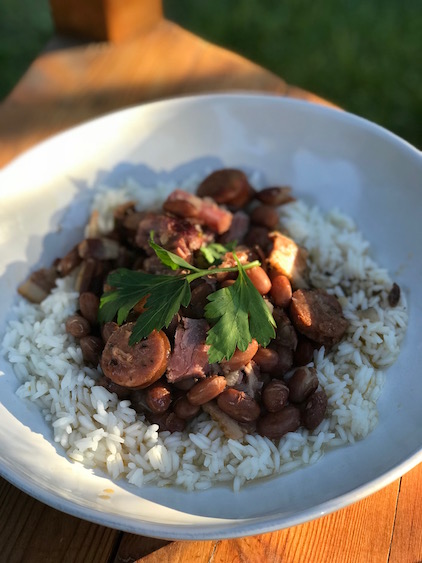ITALIAN RED BEANS AND RICE
Ciao'd while watching Monday Night Football.
Judging from this photo, no one can resist Red Beans and Rice. Back in the day, the iconic Creole dish was made on Monday using the bone from Sunday's ham supper for flavor. As the women went about their household chores (Monday was traditionally laundry day), the beans simmered leisurely on the stove. I'm guessing that the smoky, spicy, rich aroma made their tasks more enjoyable. I know it would for me.
What's not to like? Earthy, creamy kidney beans, smoky, often spicy sausage, and the salty ham bone that sends a rich ripple through the dish compose a triumvirate of tasty goodness. It's the kind of dish that even when you know you should stop eating, you insert your spoon again. And again. Red Beans and Rice brings warmth to the table on a cold day. And it's just the thing to feed a crowd.
So what's up with the Italian thing? My riff on Red Beans and Rice doesn't bastardize the original version. It tilts it just a bit. Rather than the kidney beans that form the base of the southern dish, I opted for Borlotti beans. Borlotti beans are related to kidney beans so this is not much of a stretch. That said, I appreciate the Borlotti's chestnutty flavor and creaminess. I replaced the bacon with pancetta which does take the smokiness down a notch but its quiet sweetness contributes a subtle counterpoint to the saltiness of its fellow ingredients. Basil, oregano and a generous dose of garlic round out the deliciousness.
A word about the rice. The bean mixture is traditionally served atop long-grained white rice. When I cook the rice, I toss it in butter with a dash of salt and pepper to lightly toast it prior to adding the liquid. Toasting refers to a light pre-cooking of the grain to enhance its flavor and aroma rather than imparting color to it. Some of you may recognize this as a technique employed when making risotto. Italian meet Creole. It's so nice when diverse cultures can get along.
RECIPE
ITALIAN RED BEANS AND RICE
This dish cooks at a leisurely pace but the prep is a cinch. Cook the beans until the mixture is less of a soup and more of a creamy, slightly thickened stew. If you prefer a thicker consistency, remove a cup of the beans, mash them and return to the pot. The saltiness of the meats will naturally flavor the beans. Wait until the end of cooking to adjust the seasoning, if needed.
Serves 6 to 8
1 pound dried Borlotti beans
2 tablespoons olive oil
3/4 pound smoked sausage, such as Andouille, cut into 1-inch slices
1/4 pound diced pancetta
1 medium yellow onion, chopped
2 stalks celery, chopped
1 green bell pepper, chopped
3 garlic cloves, finely chopped
Freshly ground black pepper
1/4 teaspoon red pepper flakes (optional)
1 teaspoon dried basil
1 teaspoon dried oregano
2 bay leaves
1 ham hock, about 1 to 1 1/2 pounds
Kosher salt, to taste
Chopped green onions or parsley, for garnish
6 to 8 cups hot, cooked long-grain rice
Rinse beans, place in a large deep pot, cover with water by two inches and bring to a boil. Cook for 5 minutes, cover, remove from the heat and soak 1 hour. Drain.
In the same pot, heat the olive oil over medium-high heat. Add the sausage and cook until browned, about 5 minutes. Transfer to a plate. Add the pancetta and cook until the fat is rendered. Add the onion, celery and bell pepper and cook until softened, about 5 minutes. Stir in the garlic, black pepper, and the red pepper, if using, along with the basil, oregano and bay leaves. Cook, stirring, for 3 minutes. Return the sausage to the pot along with the beans and ham hock. Add 8 cups of water.
Bring to a boil. Reduce the heat and simmer, uncovered, stirring occasionally, until the beans are tender, about 2 hours. Remove the bay leaves and discard. Remove the ham hock, pick off the meat and add to the pot. Taste for seasoning. Serve over hot, cooked long-grain rice topped with green onions or parsley, if desired.






